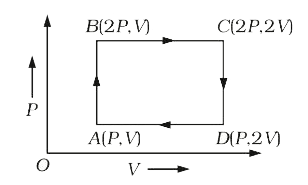The volume of air increases by 10% in the adiabatic expansion. The approximate percentage decrease in its pressure will be: (Assume γ=1.4 )
5%
14%
8%
10%
The correct Answer is:B
To solve the problem of finding the approximate percentage decrease in pressure when the volume of air increases by 10% during adiabatic expansion, we can use the relationship between pressure and volume in an adiabatic process.
1. Understand the Adiabatic Process: In an adiabatic process, there is no heat exchange with the surroundings. The relationship between pressure (P) and volume (V) can be described by the equation:
PVγ=constant
where γ (gamma) is the heat capacity ratio, given as 1.4 in this problem.
2. Initial and Final Volumes: Let the initial volume be V. If the volume increases by 10%, the final volume Vf can be expressed as:
Vf=V+0.1V=1.1V
3. Using the Adiabatic Condition: According to the adiabatic condition:
PiVγ=Pf(1.1V)γ
where Pi is the initial pressure and Pf is the final pressure.
4. Rearranging the Equation: We can rearrange this equation to find the relationship between the initial and final pressures:
Pf=Pi(V1.1V)γ=Pi(11.1)γ
5. Calculating the Pressure Ratio: Now we can calculate the ratio:
Pf=Pi(11.1)1.4
6. Calculating (11.1)1.4: We can compute this value:
(11.1)1.4≈0.8686
7. Finding the Percentage Decrease in Pressure: The percentage decrease in pressure can be calculated as:
Percentage Decrease=(1−PfPi)×100%
Substituting the value we found:
Percentage Decrease=(1−0.8686)×100%≈13.14%
8. Final Result: Therefore, the approximate percentage decrease in pressure is about 13.14%.
Summary:
The approximate percentage decrease in pressure when the volume of air increases by 10% in an adiabatic expansion, assuming γ=1.4, is approximately 13.14%.
PVγ=constant
where γ (gamma) is the heat capacity ratio, given as 1.4 in this problem.
Vf=V+0.1V=1.1V
PiVγ=Pf(1.1V)γ
where Pi is the initial pressure and Pf is the final pressure.
Pf=Pi(V1.1V)γ=Pi(11.1)γ
Pf=Pi(11.1)1.4
(11.1)1.4≈0.8686
Percentage Decrease=(1−PfPi)×100%
Substituting the value we found:
Percentage Decrease=(1−0.8686)×100%≈13.14%
The approximate percentage decrease in pressure when the volume of air increases by 10% in an adiabatic expansion, assuming γ=1.4, is approximately 13.14%.
टॉपर्स ने हल किए ये सवाल
- GASEOUS STATE & THERMODYNAMICSBook:VMC MODULES ENGLISHChapter:GASEOUS STATE & THERMODYNAMICSExercise:JEE MAIN (ARCHIVE )
Explore 81 Videos
- GASEOUS STATE & THERMODYNAMICSBook:VMC MODULES ENGLISHChapter:GASEOUS STATE & THERMODYNAMICSExercise:JEE ADVANCED (ARCHIVE )
Explore 109 Videos
- GASEOUS STATE & THERMODYNAMICSBook:VMC MODULES ENGLISHChapter:GASEOUS STATE & THERMODYNAMICSExercise:Level - 1
Explore 75 Videos
- ENERGY & MOMENTUMBook:VMC MODULES ENGLISHChapter:ENERGY & MOMENTUMExercise:JEE ADVANCE (ARCHIVE) - TRUE/FALSE TYPE
Explore 1 Video
- GRAVITATIONBook:VMC MODULES ENGLISHChapter:GRAVITATIONExercise:JEE Advance (Archive) TRUE/FALSE
Explore 1 Video
समान प्रश्न
Explain why a Carnot engine cannot have 100% efficiency?
View SolutionAn ideal gas is taken around the cycle ABCDA as shown in the P-V diagram. What is the work done during the cycle?

View SolutionFour particles have velocities 1,0,2,and3m/s. The root mean square velocity of the particles (definition wise) is.
View SolutionTwo particles of mass 1 kg and 3 kg move towards each other under their mutual force of attraction. No other force acts on them. When the relative velocity of approach of the two particles is 2m/s, their centre of mass has a velocity of 0.5 m/s. When the relative velocity of approach becomes 3m/s, the velocity of the centre of mass is 0.75 m/s.
View SolutionIs it possible to put an artificial satellite in an orbit in such a way that it always remain visible directly over New Delhi ?
View SolutionIn an adiabatic process on a gas with (γ=1.4) th pressure is increased by 0.5% . The volume decreases by about
View SolutionIn an adiabatic expansion of air (assume it a mixture of N2 and O2), the volume increases by 5%. The percentage change in pressure is:
View SolutionThe volume of air increases by 5% in its adiabatic expansion. The precentage decrease in its pressure will be
View SolutionIn an adiabatic process, the pressure is increased by (2)/(3)% . If gamma = (3)/(2) , then find the decreases in volume (approximately) ?
View SolutionIn an adiabatic expansion of the air the volume is increased by 4% what is pereentage change in pressure ? (For air y = 1.4)
View SolutionThe volume of air increases by 10% in the adiabatic expansion. The approximate percentage decrease in its pressure will be: (Assume γ=1.4 )
View SolutionThe volume of air increases by 2% in its adiabatic expansion. Calculate the percentage change in pressure.
View SolutionIn an adiabatic expansion of the air the volume is increased by 4% what is pereentage change in pressure ? (For air y = 1.4)
View SolutionThe volume of air increases by 2% in its adiabatic expansion. Calculate the percentage decrease in pressure.
View SolutionIn an adiabatic process on a gas with (γ=1.4) th pressure is increased by 0.5% . The volume decreases by about
View Solution
